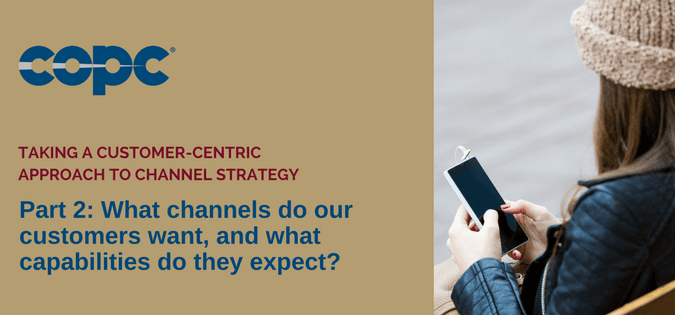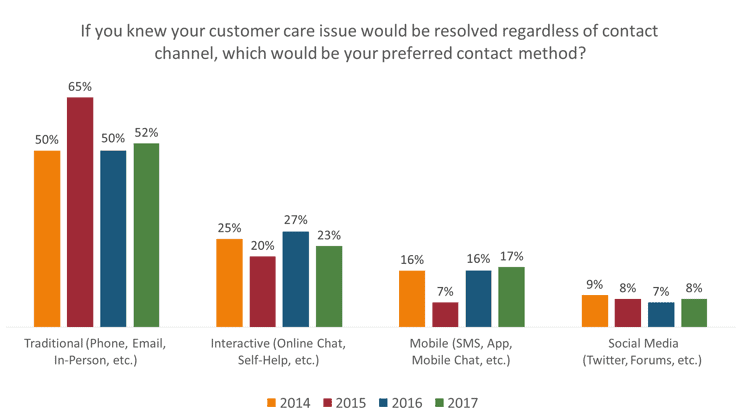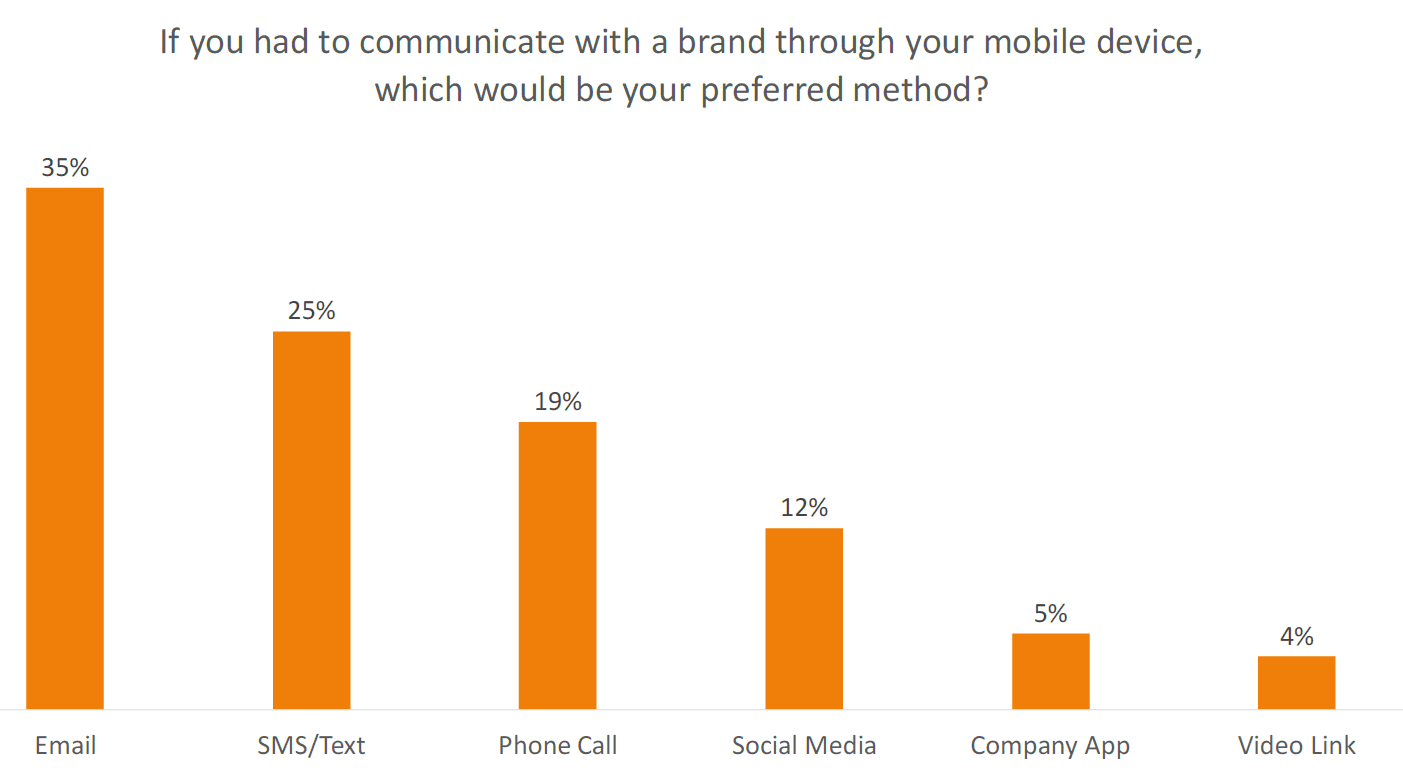
October 25, 2017
Part Two: What channels do our customers want, and what capabilities do they expect?
It’s not uncommon for companies to find themselves wondering if they are offering the right channels, why they are offering those channels, and what their long-term channel strategy should be. Even though it is easy to get excited about offering the latest and greatest channel solutions to customers, it is advisable to take a step back and view things from the customer’s perspective when developing a channel strategy.
There are four essential questions companies should be asking themselves along this journey. We will review each one of these during this four-part blog series, and they are:
Part 1: What channels do we offer, and what are our customers using?
Part 2: What channels do our customers want, and what capabilities do they expect?
Part 3: How well are we executing on what we currently provide?
Part 4: Have we identified the gaps and taken corrective action?
————————————————————————————————————-
Part 2: What channels do our customers want, and what capabilities do they expect?
What do our customers want and expect? Simple question, right? But it can take some work to find the truth when it comes to this question. Luckily, there are several methods for getting to the answer. Chief among them are Benchmarking, Industry Consumer Research, Customer Surveys and Focus Groups. In general, the first two — benchmarking and consumer research — are great ways to establish a basic direction and set of operating assumptions. Customer surveys and focus groups, however, provide information about YOUR customers and provide an opportunity for a more detailed drill down of customer wants and expectations. We will review each of these methods below.
Benchmarking
Benchmarking is a great way to get a basic foundation for what customers want and expect. It can be done quickly and with few resources. For this reason, it is often a good first step. By understanding what direct competitors and other leading companies offer, it becomes possible to understand what your customers have grown accustomed to experiencing. Not only will this provide some perspective on individual channel offerings, it will also provide some clues on the sort of capabilities customers might expect out of certain channels.
As an example, if popular, mass market brands like Amazon and Walmart offer online chat, it’s reasonable to think customers of all brands might expect such an option depending, of course, on demographics and some other factors. Similarly, if a company’s top competitor offers a fantastic mobile app with advanced functionality, like two-way communication, consumers might expect such offerings from all the brands within the segment.
Consumer Research
Like benchmarking, consumer research is a fantastic way to set a baseline. Although companies would serve themselves well to conduct custom research specific to their customers and segment, there is no shortage of existing CX-related research. One example of such research is the Customer Experience Management Benchmark (CXMB) Series, an ongoing joint research project between COPC Inc. and Execs In The Know. Figure 1 and 2 are two examples of results from the series’ most recent Consumer Edition report, providing a good indication of what consumers generally prefer. In these particular examples, Figure 1 provides a good sense for general channel preferences while Figure 2 provides insight into mobile device preferences.

Figure 1: Preferred contact method among U.S. consumers. Source: The 2017 Customer Experience Management Benchmark (CXMB) Series Consumer Edition — The Consumer’s Voice: Opinions, Perceptions and Expectations.

Figure 2: Preferred contact method via mobile device among U.S. consumers. Source: The 2017 Customer Experience Management Benchmark (CXMB) Series Consumer Edition — The Consumer’s Voice: Opinions, Perceptions and Expectations
For more information about the CXMB Series, please visit the research section of the COPC Inc. website. There you’ll find complimentary editions of past research, as well as information on how you can purchase our most recent publication, the 2017 CXMB Series Consumer Edition — The Consumer’s Voice: Opinions, Perceptions and Expectations.
Customer Surveys
Once an organization has a general idea of what its customers might want (via benchmarking and consumer research), it comes time to confirm (or dispute) some assumptions via customer surveying.
Customer surveys should be simple and short and include a representative sample of all customer personas. Surveying should also be conducted across existing channels, ensuring there is as little channel bias as possible. In other words, if surveying is only done for phone engagements, the preferences and expectations of existing alternative channels users (such as online chat or social media) might be under represented. Surveying current channel users is also the best way to gauge functionality expectations across channels. Asking online chat users whether or not they would like to be able to pay their bill through the company’s mobile app might provide results that aren’t exactly on target.
In addition to revealing what customers want and expect, customer surveying will also provide valuable information about the current experience, which will prove especially valuable when it comes time to assess the performance of current channel offerings. More on this in the next blog post in this series.
Focus Groups
Focus groups provide an opportunity to take all the learnings from benchmarking, consumer research and customer surveys, and dig deeper. Benchmarking and consumer research can provide somewhat generalized information, whereas focus groups provide a unique setting for unearthing specifics and hidden truths.
A few things to keep in mind when conducting focus groups:
1) Don’t restrict focus group research to existing customers. Cultivate an understanding of the wants and expectations of potential customers, and make sure a variety of personas are present to ensure a fair representation of the market.
2) Be careful not to lead focus group participants, and do so by leaving all bias at the door. While it’s okay to let results from benchmarking, consumer research and customer surveys lead the direction of the focus group, it should never lead the opinions of the participants.
3) Make sure everyone has a say. Don’t let the insights produced by the focus group be skewed by the more outspoken personalities in the room.
Once an organization has gathered results from these specific types of investigations, they will be well positioned for understanding exactly what it is their customers (both current and future) want regarding channel offering, as well as the capabilities of those channels.
Check back tomorrow for the next blog post in the series, focusing on this question:
How well are we executing on what we currently provide?
You can also read Part One: What channels do we offer, and what are our customers using?